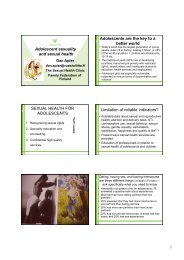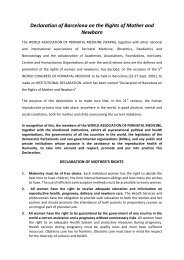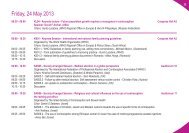Journal of Contraception Reproductive Health Care - The European ...
Journal of Contraception Reproductive Health Care - The European ...
Journal of Contraception Reproductive Health Care - The European ...
Create successful ePaper yourself
Turn your PDF publications into a flip-book with our unique Google optimized e-Paper software.
<strong>The</strong> 8th Congress <strong>of</strong> <strong>The</strong> <strong>European</strong> Society <strong>of</strong> <strong>Contraception</strong> Abstracts <strong>of</strong> Free Communications<br />
FC3-03<br />
A termination <strong>of</strong> pregnancy <strong>Care</strong> Pathway: worth the effort?<br />
K. Guthrie (1), C. Waudby (2), P. Arnott (3)<br />
Sexual and <strong>Reproductive</strong> <strong>Health</strong> <strong>Care</strong> Partnership, Hull and East Yorkshire, UK (1); Eastern Hull Primary <strong>Care</strong> Trust, UK (2); Women’s<br />
and Children’s Unit, Hull and East Yorkshire Hospitals NHS Trust, UK (3)<br />
Introduction: Termination <strong>of</strong> Pregnancy services in Hull were centralised under one consultant in 1994/5. This included a<br />
central booking line and a clinic doctors’ performa. However, co-ordination <strong>of</strong> elements <strong>of</strong> the service was difficult, duplication<br />
<strong>of</strong> work was evident and some aspects <strong>of</strong> the service were fragmented.<br />
Aims and Methods: To co-ordinate care between clinical areas, sites and pr<strong>of</strong>essions and to ensure adherence to quality standards<br />
(RCOG Guidelines), a full <strong>Care</strong> Pathway was developed with supporting guidelines and patient information leaflets. This<br />
covered the patient’s journey from considering/requesting a termination until closure <strong>of</strong> the patient episode. Variances from the<br />
pathway were recorded as a quality tool.<br />
Results: <strong>The</strong> pathway and supporting elements will be described including the first 18 months variance analysis.<br />
Conclusion: <strong>The</strong> pathway has been very well received by patients and staff, has achieved its objectives and has fully justified the<br />
effort required in its production.<br />
FC3-04<br />
<strong>The</strong> reproductive health needs <strong>of</strong> Somali women affected by female genital mutilation living in<br />
Manchester, United Kingdom<br />
N.H. Mullin (1), H. Lovel (2), Z. Mohammed (3)<br />
Highfield Clinic, Widnes, Cheshire, UK (1); University <strong>of</strong> Manchester School <strong>of</strong> Primary <strong>Care</strong>, Manchester, UK (2); Central Manchester<br />
Primary <strong>Care</strong> Trust, Manchester, UK (3)<br />
Background: Female genital mutilation (FGM), usually type 3 (the most severe form), affects over 90% <strong>of</strong> Somali women. FGM<br />
is illegal in the UK. <strong>The</strong>re is a rapidly increasing Somali population in Manchester. In other parts <strong>of</strong> the UK, special African<br />
Well Woman Clinics have been set up to provide culturally sensitive reproductive health care to women affected by FGM.<br />
Objectives: A health needs assessment was carried out to discover the reproductive health needs <strong>of</strong> Somali women affected by<br />
FGM; and to ascertain if a community family planning service could provide an acceptable service to these women.<br />
Design and methods: A systematic literature search on FGM was performed. Somali women, men and Somali health pr<strong>of</strong>essionals<br />
were interviewed individually for a video commissioned by the World <strong>Health</strong> Organisation. Focus groups comprising <strong>of</strong><br />
representatives from the local Somali population were brought together to discuss topics <strong>of</strong> concern. A health questionnaire was<br />
developed from the discussions <strong>of</strong> the focus groups and was completed by other members <strong>of</strong> the Somali community.<br />
Results: Qualitative and quantitative analysis was used. FGM was reported to have influences across the life course. <strong>The</strong> main<br />
themes were consistent with the world literature. FGM in childhood is normal in Somali and is <strong>of</strong>ten associated with acute<br />
health problems including pain, bleeding, infection and urinary retention. Menstrual problems may occur in puberty, sometime<br />
necessitating de-infibulation (re-opening). In later life there may be sexual problems, effects on fertility and childbirth. We<br />
discovered socioeconomic and sociocultural reasons facilitating continuation and factors against FGM. Women complained <strong>of</strong> a<br />
lack <strong>of</strong> knowledge and understanding by UK doctors and midwives. This Somali population expressed a desire to have easy and<br />
timely access to the FGM reversal operation (before marriage and pregnancy) rather than having to wait to see the local female<br />
hospital gynaecologist.<br />
Conclusions: <strong>The</strong> adult Somali female population in Manchester suffers many complications <strong>of</strong> FGM. <strong>The</strong>re is a need for an<br />
improved FGM reversal service in Manchester. This could be provided by the local family planning service when an acceptable<br />
location for the clinic is established and medical staff with gynaecological experience have been trained in the simple reversal<br />
procedure. Further work on FGM issues is being carried out within the Somali community.<br />
38 <strong>The</strong> <strong>European</strong> <strong>Journal</strong> <strong>of</strong> <strong>Contraception</strong> and <strong>Reproductive</strong> <strong>Health</strong> <strong>Care</strong>








